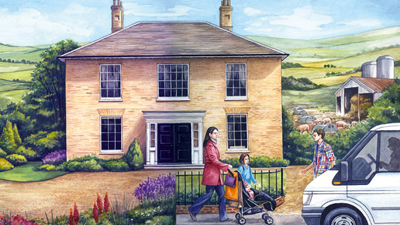What makes and breaks a house?
What is it that adds value to a country house, and what takes it away? Tessa Waugh finds out the different elements which can make or break a house's value


Everyone knows that location is the most important variable when it comes to buying a property. The most quintessential Georgian gem can quickly lose its charm (and value) if located next to a commercial pig unit or someone who spends their life tormenting the neighbours.
The location turn-ons are similarly universal and most buyers, at the top end of the market, wouldn't be beyond selling a vital organ in order to secure a family house with one or more of the following: a village-fringe location, proximity to good schools, a gastropub and a mainline train station. Agents tend to agree on the location issues concerning today's buyer, but they're reluctant to quantify exactly how much these factors can affect a property's value: the popular view is that this will vary too much from property to property and from buyer to buyer.

The school factor
However, someone who is willing to discuss figures is Philip Selway of buying agents The Buying Solution: ‘Schools are our number one driver when it comes to people leaving London for the country. A house that's a 15-20-minute drive from a good school can expect an added value of up to 15%.' Will Peppitt, director of Savills Country Department, concurs: ‘The biggest catalyst for a move is school. Places such as Kent are extremely sought-after at the moment, because it's one of the few counties that still has grammar schools.'
James Grillo, director of Country at Chesterton Humberts, has witnessed the school-led market increase in momentum in recent years and attributes it to several factors. ‘There has been an increase in weekly and part-time boarding, and sending children to board at prep-school age is not as popular as it used to be.' This means that houses within striking distance of places such as Cheltenham, Oxford and Salisbury are increasingly sought-after.
Quality of life
Transport links are always going to be a priority for buyers when it comes to getting the breadwinner(s) in and out of their chosen centre, but less obvious attractions such as the proximity of the local gastropub also loom large.
Sign up for the Country Life Newsletter
Exquisite houses, the beauty of Nature, and how to get the most from your life, straight to your inbox.
Philip Selway puts a 12% increase on the value of a property with a good pub in the area. In particular, he believes: ‘Clients moving out of London don't want to feel as if they're moving into a desert. A gastropub in the vicinity is very important to their quality of life.' Rupert Sweeting, partner at Knight Frank, says it goes beyond that. ‘A gastropub is indicative of better amenities all round. Kingham in Oxfordshire is the classic example, with two good pubs and a station that's an hour and 20 minutes from London.' The same goes for high-end supermarkets such as Waitrose or delicatessens such as Daylesford.
Too much of a bad thing
When it comes to negative location factors, James Grillo says: ‘Anything that distracts from the quiet enjoyment that people believe they're going to have [in a country location] can be a problem.'
Although wind farms and electricity pylons often cause alarm, farmyards and noisy roads come top of the list. Will Peppitt is adamant about this. ‘No one wants to live on a busy road. Even if you'd lived next to London's South Circular, you wouldn't want to move to a house near a road.'
Although most agents would give unsightly or smelly farmyards and busy roads equal weight, Mr Grillo believes farmyards can present more of an issue. ‘The perception of a road is often worse than the reality, because noise and safety issues are easily mitigated with serious fencing and careful planting of trees. Noise and disruption from a farmyard is less easily controlled.'
People who move out of London to find a rural idyll can be taken by surprise, adds Mr Grillo. ‘Many are unaware that the country is shop floor; cows have to be moved and milked, grain has to be dried. I once had trouble selling a house located next to a flock of organically reared geese.' Will Peppitt has also encountered this kind of scenario: ‘I took some clients to see a beautiful old rectory in Dorset, which was next to a farmyard with a slurry pit. The clients loved the house, but they didn't buy it because most of the upstairs windows shared a view of the farmyard.'
It's never a bad plan to keep an eye on the future either, so try to hedge your bets. Charlie Wells from Prime Purchase cautions against what he refers to as ‘one-hit-wonder locations'.
‘The school could be a really desirable draw, but if it goes downhill, there's nothing else to bring people to the area.' Similarly, if the pub closes or the previously quiet farm steading is sold to a motorcycle repair shop, last year's pleasure could quickly evolve into this year's pain. Ideally, a house will boast more than one positive location factor. Knight Frank's Rupert Sweeting advises: ‘It's no secret that period gems close to Oxford, with good access to Oxford schools and the A40, sell really well.'
Top five location positives * Proximity to good schools * Good transport links * Close to renowned gastropub, Waitrose or Daylesford * Neighbouring land is development protected * Situated on the edge of a village with views over countryside
Top five location negatives * Next to a busy road * Close to an untidy/smelly/noisy farmyard * Unresolved planning issues in immediate vicinity * Wind turbines, solar farms or electricity pylon in sightline * Intrusive or anti-social neighbours Double-edged location features * At the end of a long drive-increased security, or too isolated? * Adjoining land/property for sale- an opportunity, or a worry? * Next to a river-a recreation opportunity, or potential hazard?
* Follow Country Life property on Twitter
Country Life is unlike any other magazine: the only glossy weekly on the newsstand and the only magazine that has been guest-edited by HRH The King not once, but twice. It is a celebration of modern rural life and all its diverse joys and pleasures — that was first published in Queen Victoria's Diamond Jubilee year. Our eclectic mixture of witty and informative content — from the most up-to-date property news and commentary and a coveted glimpse inside some of the UK's best houses and gardens, to gardening, the arts and interior design, written by experts in their field — still cannot be found in print or online, anywhere else.
-
 RHS Chelsea Flower Show: Everything you need to know, plus our top tips and tricks
RHS Chelsea Flower Show: Everything you need to know, plus our top tips and tricksCountry Life editors and contributor share their tips and tricks for making the most of Chelsea.
By Amie Elizabeth White
-
 Hidden excellence in a £7.5 million north London home
Hidden excellence in a £7.5 million north London homeBehind the traditional façades of Provost Road, you will find something very special.
By James Fisher